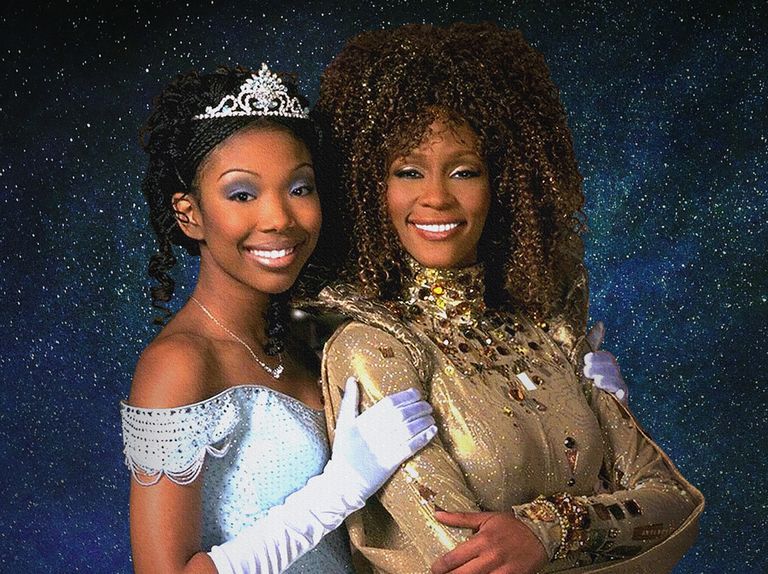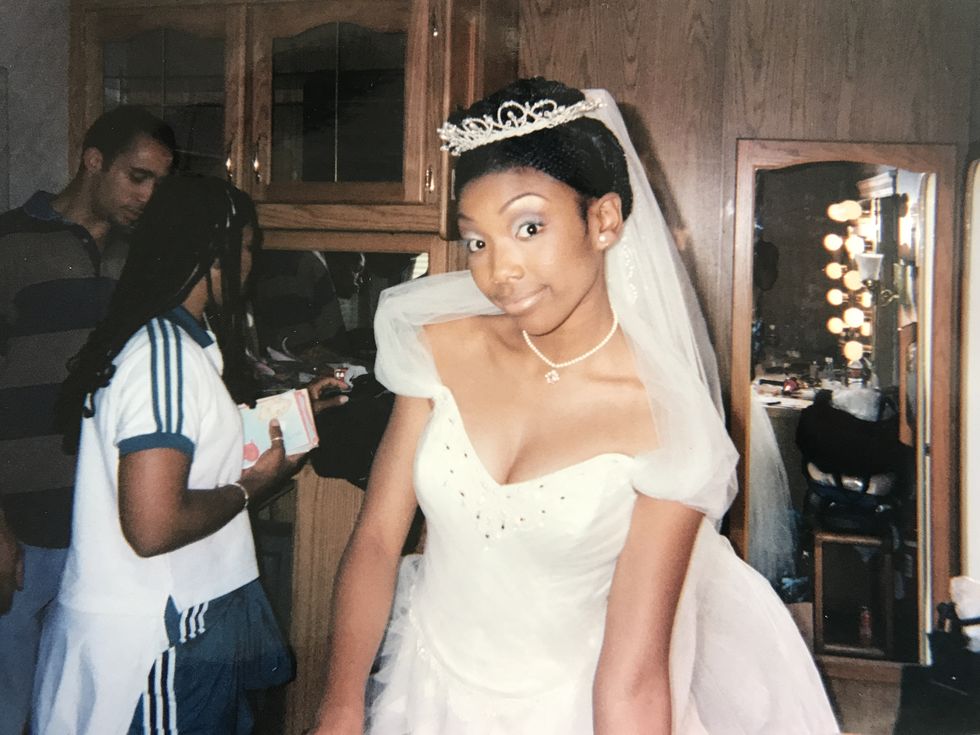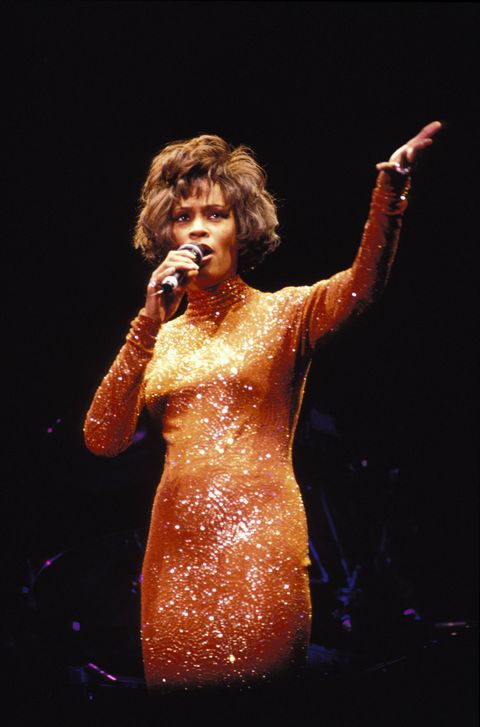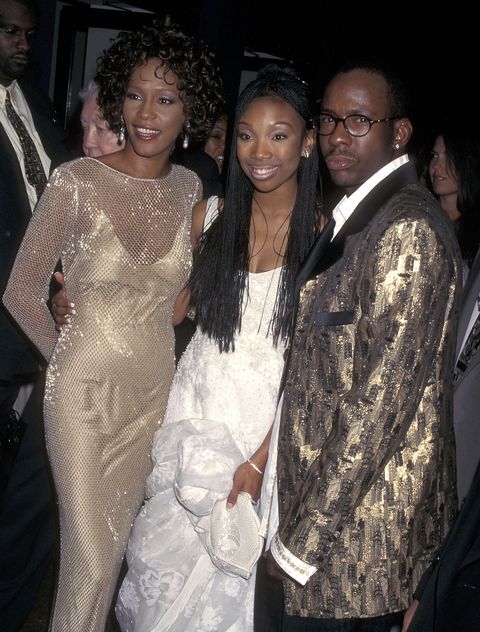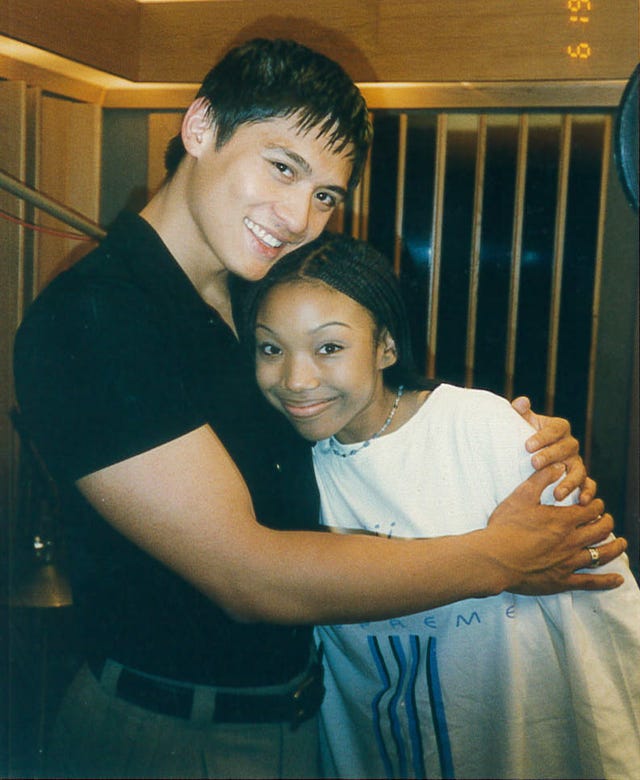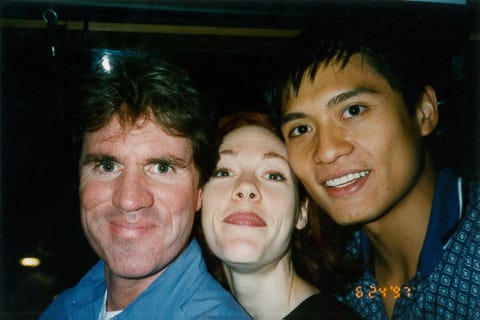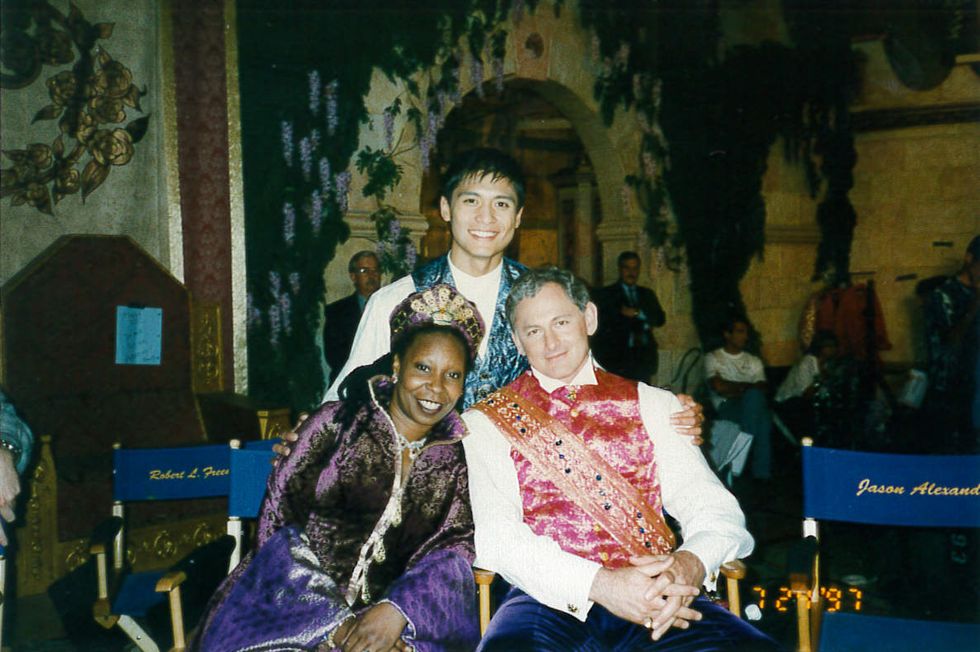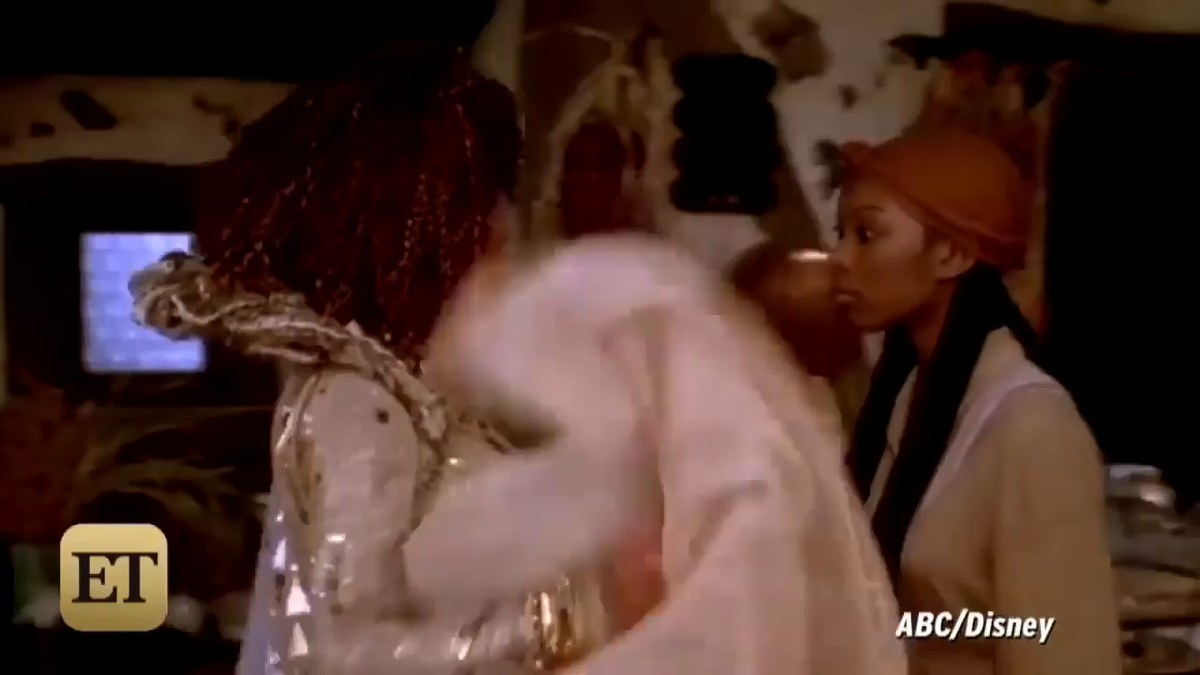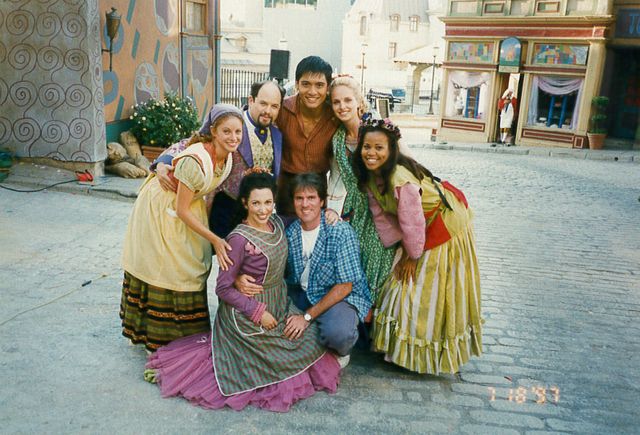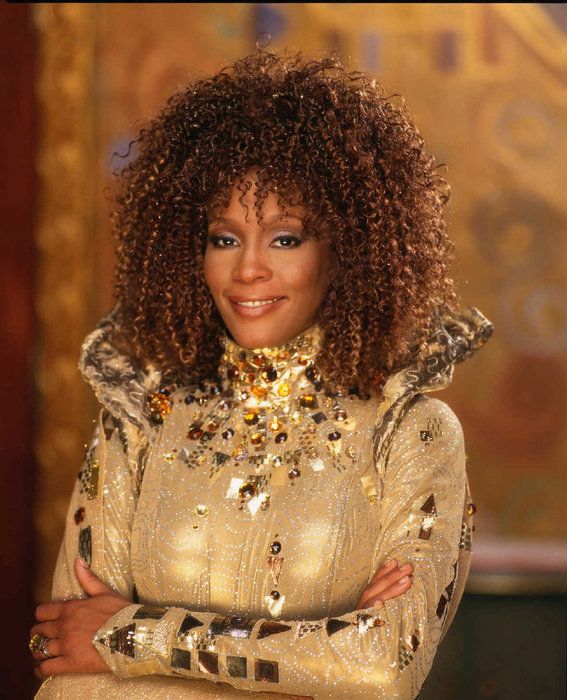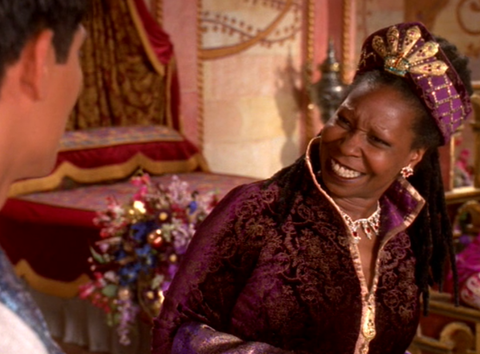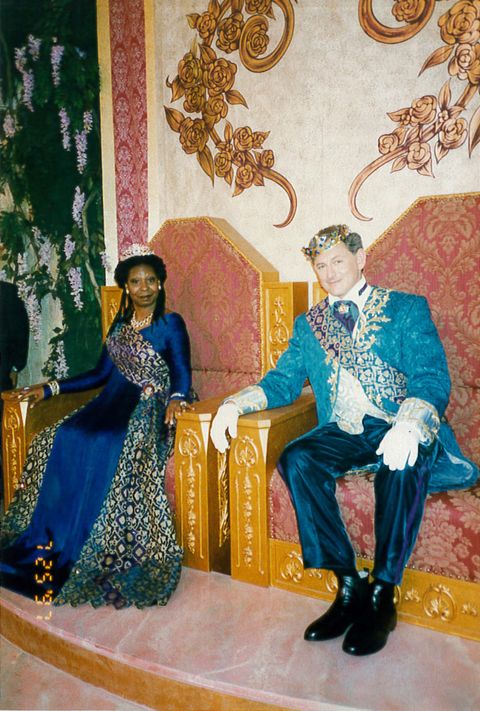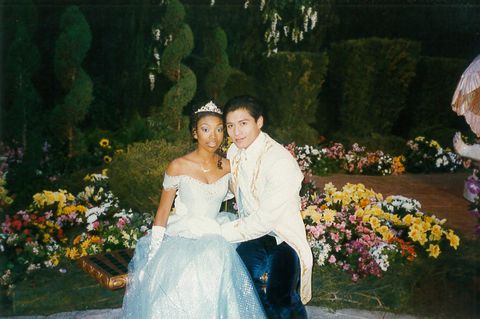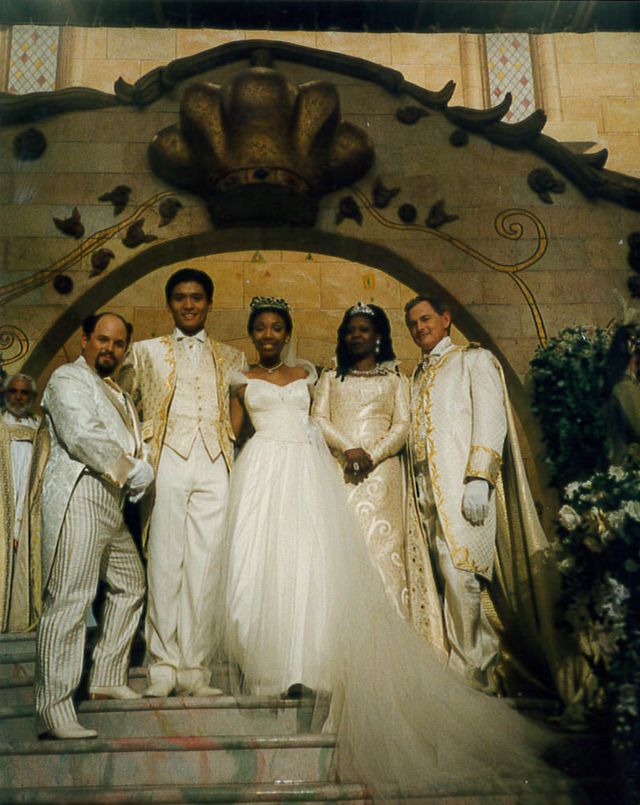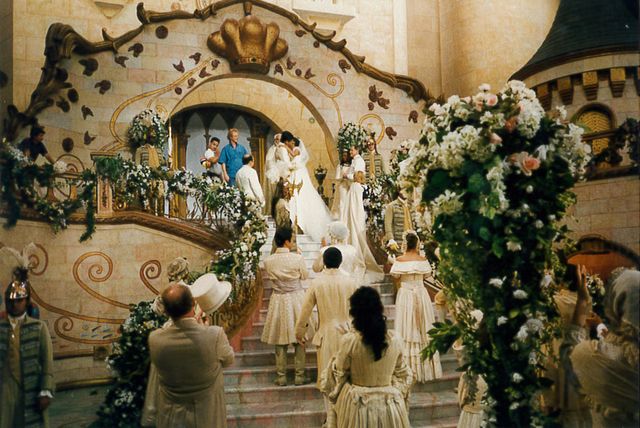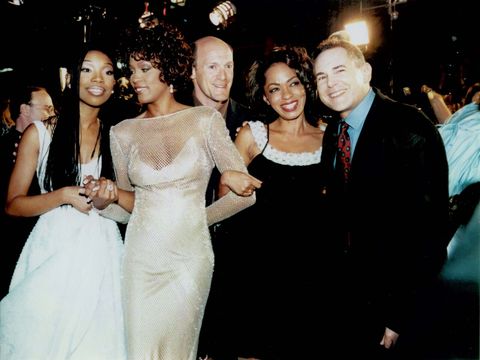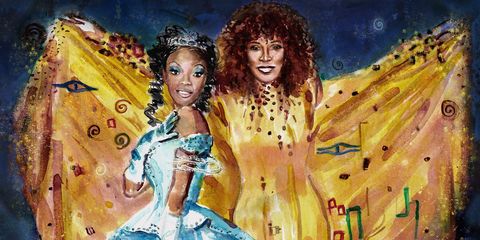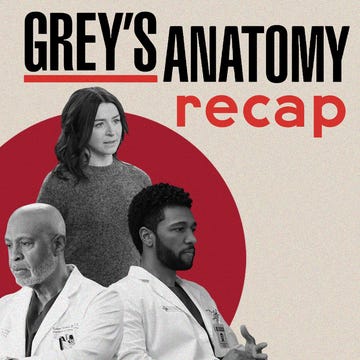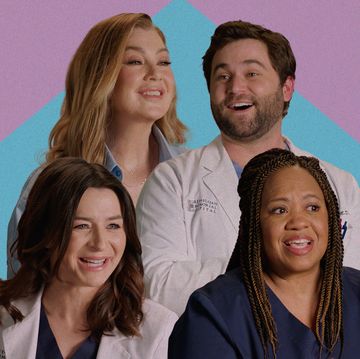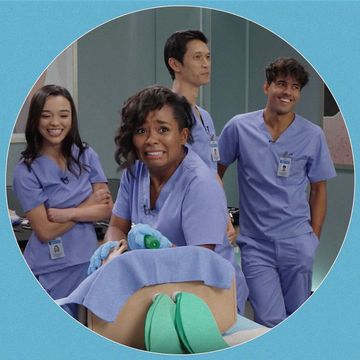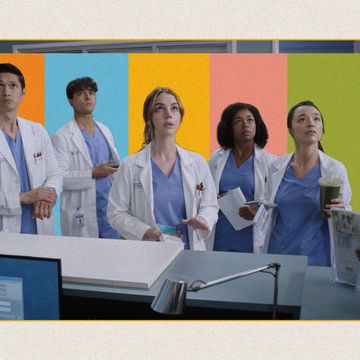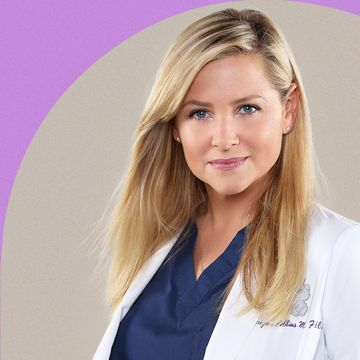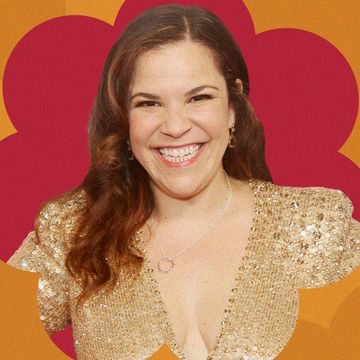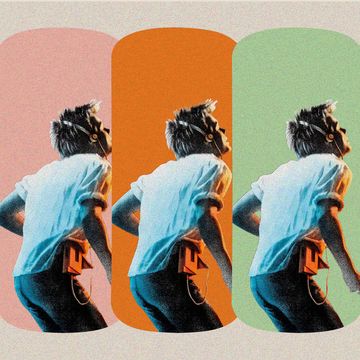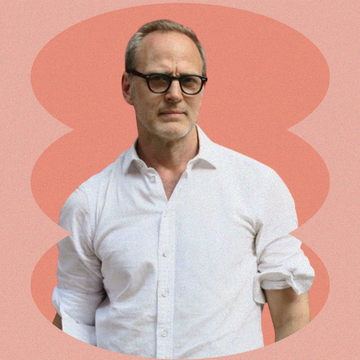When shooting began for Rodgers and Hammerstein’s "Cinderella" in July of 1997, the closest Disney had come to showcasing a black princess were the muses from "Hercules." In fact, it would be another 12 years before an (animated) black girl got the lead in "The Princess and the Frog." But megastar Whitney Houston didn’t want to wait. Instead, the Grammy and Emmy Award-winning artist set out to make a diverse, multicultural "Cinderella," starring a young Brandy Norwood — who would become Disney's first black princess.
Remaking "Cinderella" had been on Houston’s mind for years; long before any footage was shot, before glass slippers were fitted, before anyone thought that Cinderella could have microbraids. Houston and her co-producers knew how important it was for each modern generation to have their own "Cinderella" — and for many young black girls growing up in the 90s, Brandy was ours.
The story of a down-on-her-luck, fatherless girl saved from her wicked stepmother by a fairy godmother and a handsome prince goes back to 1634, when it was first published by Italian author Giambattista Basile. It, of course, went on to become one of The Brothers Grimm’s best known works, published in their 1812 fairytale collection. Silent film star Mary Pickford played the character in a 1914 movie, and in 1950, Walt Disney and his animators gave us their first animated interpretation of the tale. CBS first staged a live version of the "Cinderella" musical in 1957. It starred a young Julie Andrews and was watched by over 107 million Americans. In 1967, CBS reimagined the musical once again. Lesley Ann Warren’s portrayal of Cinderella was so successful that it was rebroadcast eight times, essentially once a year through February of 1974. Warren’s Cinderella became annual "event watching" in many households, catching the eyes and imaginations of more of America’s kids each time it aired.
More than two decades later, Norwood and Houston's "Cinderella," which was first broadcast by ABC on November 2, 1997, went on to do the same thing for a whopping 23 million households (and an estimated 60 million viewers) in just one night. The casting of this "Cinderella" was historic and not without its detractors — not since "The Wiz" had a production dared to imagine that a story so firmly fixed in the cultural zeitgeist could be seen as anything other than lily white. And for a generation of young children of color, "Cinderella" became an iconic memory of their childhoods, of seeing themselves in a black princess who could lock eyes and fall in love with a Filipino prince. Whitney Houston’s persistence had paid off, her dream of a multi-cultural "Cinderella" production was realized, and its effect was achieved.
In honor of the film's 20th anniversary, Shondaland spoke with "Cinderella"'s living cast and crew — including actors Brandy Norwood, Paolo Montalban, Bernadette Peters, Whoopi Goldberg, Jason Alexander, and Victor Garber; along with executive producers Debra Martin Chase, Craig Zadan, and Neil Meron; director Robert Iscove, writer Robert L. Freedman, choreographer Rob Marshall, and costume designer Ellen Mirojnick. We asked them how it all came together, the challenges they faced, and how they each found themselves making one of the most inclusive, expensive (with a $12 million budget), and ultimately beloved TV movies of all time.
Once Upon a Time: How “Cinderella” Came to Be
When they were children, producers Craig Zadan, Neil Meron, and Debra Martin Chase had all watched and been enchanted by Warren’s portrayal of "Cinderella" on TV. In 1993, they were producers looking for their next projects — when they heard Whitney Houston wanted to do a musical, they each instinctively felt "Cinderella" would be the perfect fit.
Neil Meron (Executive Producer): Surprisingly, the journey began at CBS — not with Disney. Craig and I had just done the musical "Gypsy" for CBS starring Bette Midler. It was a gigantic success and it was really the first movie musical that was done on TV I think in forever. This was in 1993.
After "Gypsy" aired we were called into Jeff Sagansky’s office, who was head of CBS at that time, and he went, "OK, what’s next?" We’d had a call from Nicole David, Whitney’s longtime agent at WME, who’d said, "Whitney watched ‘Gypsy’ and she wants to do one. What ideas do you have?" For whatever reason, I pitched her "Cinderella." I had seen kinescopes of the original Julie Andrews "Cinderella" and then, of course, there was the Lesley Ann Warren version, which I loved at the time.
Craig Zadan (Executive Producer): At that point, Whitney was going to play Cinderella. She was also attached to be a producer with us from the get-go. We actually didn’t meet her partner, Debra, until way down the road. But Robert Freedman, who wrote the script, was around pretty quickly if I’m remembering correctly.
Robert Freedman (Writer): I actually got involved in ‘93 when Whitney was supposed to play Cinderella. I’ve never done this before or since, but… I saw a little story about "Cinderella" in Variety at the time, and it said CBS was gonna do "Cinderella" again. I don’t even know if it said Whitney Houston, but it said Craig and Neil. That was enough for me. I said to my agent, "Can you get me a meeting, I’m perfect for this." I had been in love with the "Cinderella" that was done in the 1960s with Lesley Ann Warren, and I just saw this and my eyes lit up. So I got a meeting with Craig and Neil; they couldn’t have been nicer and we hit it off.
Neil Meron: Robert was one of the best known TV writers of the time. Didn’t have much experience doing musicals, nor did any of us. But he did a remarkable job.
Craig Zadan: I just remember the three of us throwing around a lot of different ideas, because we were breaking new ground with the piece. We knew that we were going to do something that was completely multicultural.
Debra Martin Chase (Executive Producer): I grew up watching the Lesley Ann version of "Cinderella." That was an annual major event in my house. So I was enthralled with the idea of doing a new "Cinderella," and having her be of color. I knew how much it would have meant to me as a little girl.
I was running Denzel Washington’s production company, Mundy Lane Entertainment, and I had developed "The Preacher’s Wife" from scratch while I was there. Whitney signed on relatively early to be in the movie, and I got to know her and her team on that project. We developed a really good relationship — by the time I started working with her, "Cinderella" was already in her orbit. It had just been sitting there for awhile, dormant. Neil and Craig were some of the first people on my call sheet when we started the production company, and they were like, "We’ve been trying to get traction on this!"
Neil Meron: We formed a relationship with the Rodgers and Hammerstein Organization, led by Ted Chapin. We were a little worried that they would balk at the idea of doing "Cinderella" with a diverse cast, because that was the idea right from the start: It was going to be a diverse world that we would present. There was no pushback from the organization at all! I think it was because Whitney was so huge at that time; to a lot of executives she was popular entertainment as opposed to being defined by her race. We were also worried about making sure that Cinderella that was defined by more than falling in love with a handsome prince. She needed to have a story of her own that superseded just being attracted to his good looks. That’s not the way that the culture was going at that time. Robert was able to give her a little bit more of a backbone and have her be an independent woman.
Robert Freedman: I wasn’t thinking about how to write it multiculturally, I was thinking about how to write for 1997, for young girls watching it. My wife told me about how women were depicted affected her growing up — you know, like in those Doris Day movies, and even in the past "Cinderella"s. I was particularly sensitive to not telling a story of "she’s just waiting for the prince or the white knight on the white horse to come and take her away." I’m not saying that it’s the most feminist movie you’ll ever see, but it is compared the other versions.
There was a lot of rewriting between 1993 and 1997. The producers were worried about having a script ready for Whitney to read. They were worried about moving the whole project forward.
Disney and Whitney Houston: “Cinderella”’s Fairy Godmothers
Debra Martin Chase: Whitney, bless her heart, took a long time to focus and make decisions.
Craig Zadan: Whitney was so gigantic, and so in demand at the time. She had so many other concrete things that she was doing that "Cinderella" took a back seat and, as the time went on and executives started changing at CBS, we got a call from Michael Eisner, the head of Disney.
He said, "I’m thinking of resurrecting ‘The Wonderful World of Disney.’ But I don’t want to launch it with some programming or some movie, I want to launch it with a big event. Do you have any ideas of what you might be able to do?"
We told him, "Actually, we do." And we pitched "Cinderella" with Whitney. Of course, he went nuts, and said, "Oh my god, there’s nothing bigger than this." He immediately said, "Let’s do this, I will commit to this as the launching of ‘The Wonderful World of Disney.’"
Neil Meron: This must have been 1994 or 1995. I don’t remember the exact year, but it took awhile.
Robert Freedman: So once Disney committed, we had to get Whitney to read a draft of the script. Remember, she still wanted to be Cinderella.
Craig Zadan: We gave her the script, and then we called every week. And Nicole David said, "Well if you were at her house you’d see that next to her bed is her night table, and on the night table is the script." That script must have had so much dust on it, because this conversation went on for months.
Robert Freedman: Months go by and then finally in 1995 Craig and Neil decided to do a live reading in New York City — Whitney lived in New Jersey, at the time.
Craig Zadan: If she wasn’t going to read it then we were going to read it to her.
Neil Meron: So we took a penthouse suite for the afternoon, at the Rihga Royal Hotel. That’s the London Hotel now, but it was Whitney’s favorite back then. A comfortable and familiar spot.
Robert Freedman: We got the best Broadway actors to come. I think we had LaChanze [Tony Award-winning Broadway actor for "The Color Purple"] as Cinderella, we had Brian Stokes Mitchell [multiple Tony Award-winning Broadway actor] as the prince, and Theresa Merritt [a Tony Nominated Broadway actor and star of "The Wiz"]as the Fairy Godmother.
Neil Meron: And Dana Ivey [Tony Nominated and Drama Desk Award-winning actress] was the Wicked Stepmother. We catered lunch and everything.
Robert Freedman: Now, remember that Whitney is still planning on playing Cinderella at this point, and we couldn’t move forward in the production until Whitney said OK. Whitney was supposed to come after lunch, and sit down and be entertained by this group. Well, lunch was over, an hour went by, we find out Whitney's going to be late. Another hour goes by — I mean, she was really late.
Neil Meron: She must not have shown up until around 5pm. Dana was pissed.
Robert Freedman: She eventually came in with Bobby Brown and a couple other people. Maybe her record producer was there. My memory of it is that the actors were so good in the morning, but by this time they’d been waiting around. Also the hotel had opened the bar, and so I won’t name any names but there was at least one person who’d had a little to drink.
Neil Meron: We immediately got into the reading of the script. Whitney just kind of followed along.
Craig Zadan: She never looked up at the cast once during the reading. She just followed along in her script. She went line by line reading it while they were reading it.
Robert Freedman: I know I was nervous, as well. We couldn’t gauge her reaction at all!
Neil Meron: At the end of the reading, she loved it. She thought it worked beautifully. I know that Whitney sent flowers to all of the actors because she felt so bad about how late she was. That reading was the turning point in terms of getting her to finally and absolutely commit.
Debra Martin Chase: We’d been inching towards that green light [from Whitney]. We were bugging Whitney, like, "We need you to commit. We need you to commit!" It was just constant. Nicole and I were having lunch in Beverly Hills. One of our assistants called the restaurant looking for us (this was before cellphones) and I got on the phone and Whitney was like, "I’m in. I’ll do it." I swear, Nicole and I were both jumping up and down in the restaurant.
Neil Meron: By the time it was settled, Whitney felt that she was kind of too old to play Cinderella.
Debra Martin Chase: Because this took so long,however, I started to realize that Whitney was past the time to play Cinderella. Luckily, when I talked to her about it, she agreed. We both knew that everyone still had images of Diana Ross, who is absolutely incredible, but who was a little old to be playing Dorothy in "The Wiz." So Whitney and I decided she would play the Fairy Godmother instead — ultimately something that she was a little more comfortable with.
Robert Freedman: Whitney deciding to be the Fairy Godmother kicked off the next round of rewriting.
Craig Zadan: So we started putting it together in that way: Whitney had moved to the Fairy Godmother and she decided that a singer and actress named Brandy Norwood would become Cinderella. Then we started the real development process. That’s when it really began in earnest.
Casting Cinderella
Though she left all other casting to the producers and directors, Houston was set on Norwood for the leading role — and wanted to handle outreach herself.
Brandy Norwood (Cinderella): Whitney called me at home on my house phone in Carson, California. Imagine — anyone could have picked up! Luckily I grabbed it, and I hear Whitney on the other end, "Brandy, what do you think about being Cinderella?"
"Cinderella-Cinderella?" I asked.
And she said, "Yes, I think you would be great in this role." I mentioned that I thought she was going to be Cinderella, because it was going around that the movie was going to be made. I’d heard through the grapevine that Whitney was going to be Cinderella, and I thought that was great casting.
But she said, "No, I’m gonna be your Fairy Godmother."
I screamed at the top of my lungs and ran all around my house. I left Whitney Houston on hold!
Finally got back to the phone and I told her, "I would be honored. Of course!" But I was thinking, "I gotta get my sh*t together. This is Whitney! I have to be on point. I have to be good." I couldn’t believe it. I was young, and all of my dreams were coming true. I was so thankful, and I couldn’t wait to work with her.
Neil Meron: This seemed like a bit of cinematic magic and synergy. Brandy was at that point one of the biggest TV stars, with "Moesha," and of course, Whitney was Whitney. It was perfect.
Robert Iscove (Director): Brandy was very young, very into it, and just full of this… enthusiasm and joy and happiness that just radiated from her.
Robert Freedman: Everybody fell in love with her immediately.
Brandy Norwood: My mom told me after I got the role, she said, "I told you that you would meet Whitney at the top." There was this time I’d tried to meet Whitney when I was much younger. I talked my way down from this nosebleed section at a concert. I managed to get backstage by telling all the security guards that I was going to be famous and would be able to pay their bills one day. But by the time I got backstage, she was gone and I couldn’t meet her. I was upset, but my mom said, "Don’t worry. You’ll meet her at the top." And sure enough I met her there! She knew that I existed! She knew my music! It still feels surreal.
Craig Zadan: Though I’ll tell you what was going on behind the scenes: There was an executive at Disney — who will remain nameless — and he was very nervous about a black Cinderella. He loved the idea of Whitney being the black fairy godmother, but he came up to us and said, "Well, if you’re coming up with someone like Brandy as Cinderella, why can’t you go get Jewel instead, and have a white Cinderella and a black Fairy Godmother. It’ll still be multicultural." I think he was saying to himself, "Who’s a white version of Brandy?" We said absolutely not. The whole point of this whole thing was to have a black Cinderella. We didn’t want to make it with a white Cinderella. We weren’t interested in a white Cinderella. Still aren’t! We never approached anyone other than Brandy for the role, and Jewel was never approached.
Debra Chase Martin: Jewel as Cinderella would have been a nonstarter.
Neil Meron: It was always Whitney and Brandy. This exec was doing this independent of the network. Michael Eisner had nothing to do with it— he backed us completely.
Craig Zadan: But it’s important to mention because it shows that even at that moment there was still resistance to having a black Cinderella. People were clearly still thinking, "Multicultural is one thing, but do we have to have two black leads?"
Robert Freedman: We met with Brandy and her parents on the set of "Moesha." They ordered chicken and waffles, and we sat and talked.
Brandy Norwood: Debra, Neil, Craig, and a few others sat me down for lunch. They broke it down for me. "This is gonna be a multicultural cast. Trust us." I thought, Wow, that’s different. I didn’t know what to think at first because I hadn’t seen it done. I was just happy to be Cinderella. I never felt like we were "breaking the rules," but I knew that we were doing something different.
Finding Prince Charming (and Everyone Else)
With both Norwood and Houston on board (and the idea of Jewel firmly nixed), it was time to cast the rest of the musical.
Debra Martin Chase: I remember casting this thing was like being in a damn war room.
Neil Meron: Craig and I started in the theater, and we worked for a man named Joseph Papp at The Public in New York. One of his mantras, the philosophy that begat "Hamilton" in fact, was to do color blind casting and always cast with diversity. It informed how we looked at the world and how we looked at our projects. We want to reflect the world we’re working in. Since were going for this multiracial cast, choosing actors was kind of a checkerboard that we had to examine just in terms of keeping the proper balance.
Debra Martin Chase: Craig and Neil and I were in our office, days and nights on end. Endlessly pounding agents and any contacts we had to get great people, the right people, in these roles. Live musicals were not in the culture at the time. So people were reticent about song and dance and putting themselves out there.
Craig Zadan: We really needed stars in order for this to move forward for all the roles. The person we went to early on was Whoopi Goldberg. She said to us, “If you need me later on I’m there for you.” So we had her in our back pocket.
Debra Martin Chase: The first real success was Jason Alexander. He was still doing "Seinfeld." The opportunity to sing and dance was attractive to him; he’s a theater guy at heart.
Jason Alexander (Lionel): I knew Craig and Neil, and I think they just called with the offer out of the blue. It was very fast. When I was on "Seinfeld" the windows of opportunity for me to do other projects were relatively small, because we worked from August to April. This was a project happening very quickly and in July. It was a pretty perfect offer.
Robert Freedman: I was told, "You better rewrite the part of Lionel to fit Jason Alexander." So I did, happily. Then he arrives and I was told, "He doesn’t want to anything that’s remotely like George Costanza!" I’d given him all these funny, very George lines, so I had to rewrite it again.
Debra Martin Chase: The hardest role to fill was the Stepmother. That was the role we approached Whoopi with first, actually. But she was busy, and very kindly said we could circle back to her later on.
I cannot emphasize enough what a bitch it was to cast this role. No white actress wanted to be seen as being mean to the black Cinderella. We went to Bette Midler — I remember Bette in particular, because Craig and Neil had done "Gypsy" with her. She and different people kept giving us the same "no" response. I would write these long letters putting the role in context, explaining the importance of what we were doing with the multicultural cast, and the cultural impact we hoped to have. I wanted them to understand that they wouldn’t just be coming on board for a great show; it was also going to be important culturally.
Bernadette Peters: Craig and Neil invited me to come and play this wonderful role, and I immediately said yes. I don’t remember if I thought about the optics of playing a white evil stepmother to a black Cinderella. We weren’t really playing ‘real’ people — it’s a fairy-tale, and I just wanted to play the role as best as I could, as cruelly as I could. I think that’s how we all approached it.
Neil Meron: Then we decided that it would be terrific for one stepdaughter to be white and one daughter be black just to further hit home that color is irrelevant in this fantasy world.
Robert Iscove: We had a ton of girls reading for the stepsisters out here in LA. Probably every young actress around. We read them individually and then we read them in pairs. There was just something magic between Veanne Cox and Natalie Desselle when they read together. We all kind of looked at each other and said, "Look no further: That’s it."
Debra Martin Chase: There was a big chunk of this casting process where I just wasn’t sleeping. One night we were having another late night session at WME and I walked outside and burst into tears.
Nicole’s assistant came out to see if I was OK and said to me, "If this were easy, it would have been done before." Those were the right words at the right time to snap me out of it. I said, "OK, this is what it feels like to be making history."
Neil Meron: With all of these big Broadway and movie names, the budget was already inflating, so we had favors worked out with all the [actors] regarding their weekly pay.
Debra Martin Chase: If you think we talked to them, we talked to them. Julie Andrews was at the top of our list to play the Queen, we may have talked to Michelle Pfeiffer, as well. It was right around the time that Julie found out that her vocal cords had been damaged, so she ended up not being able to do it.
The clock was ticking. So Neil then said, "Let’s go back to Whoopi."
Whoopi Goldberg (The Queen): I got a phone call from Craig and Neil. They said, "Are you in?" I was like, "Sure." It’s Whitney Houston, it’s Brandy, and Victor is one of my favorite people from years back. I’ll do whatever you want!
Debra Martin Chase: Whoopi was the one who brought up Victor Garber initially. And it was Victor’s transition from theatre to film and television. He really took off after "Cinderella."
Victor Garber (The King): I got a call saying, "They want you to do 'Cinderella,'" and I think Rob Marshall may have called me to plead the case too; we were good friends. It was the first time I’d worked with Neil and Craig and I was thrilled to be asked. There was never a question of whether I would do it. The cast list was overwhelmingly impressive. The idea of being next to Whoopi at any time is a gift. I stepped into a situation where I knew I would be treated wonderfully and be protected.
Craig Zadan: The only pushback we got was when that exec was pushing Jewel. We even got the dancers we wanted — we cast Latino, Asian, white, and black dancers.
We were so consumed with making sure that we didn’t let any area of the production fall into an easy casting situation. For each and every detail, we wanted to make sure we were meticulous with how we put these roles together.
Neil Meron: The last person we cast was the Prince.
Craig Zadan: We had an issue: Do we cast a black or Latino prince, do we cast a white prince, or do we cast an Asian prince? We wanted to make sure that we were true to the multicultural vision, and also we wanted to make sure Brandy was comfortable.
Brandy Norwood: I trusted our team, our producers — but not everyone was open minded back then. I was, but my concern was, "Is this going to look realistic to America?"
Debra Martin Chase: It was like we had the glass shoe that we were trying to fit for the Prince. We held auditions in LA and we saw everybody from Wayne Brady to Antonio Sabato, Jr. It was a huge deal. We just didn’t find the person in LA, so we went to NY. Taye Diggs even came in in New York and there was a lot of anticipation because of "Rent."
Neil Meron: I believe we even saw a young Marc Anthony as well!
Debra Martin Chase: Towards the end we were like, "We haven’t found him. Oh, God." Literally Paolo was the last guy to come in on the last day in the last hour.
Paolo Montalban (The Prince): I was understudying for the Young Lover in “The King and I” on Broadway, and was also in the chorus. It’s like one of those things where forces outside of myself were at play that day. I actually had an understudy rehearsal that day, and I had to tell the "Cinderella" casting people that I couldn’t make it until much later. Then I was running late on top of that, and when I got there, I think I was the last person to audition for them.
Debra Martin Chase: He opens his mouth and he sings like an angel. And we’re just like gasping, "We’ve found him."
Paolo Montalban: This was before the internet, so you couldn’t really do the things that you do to today for auditions, where you look up who’s producing, who’s directing, who’ll be in the room. My agent at the time had mentioned that Whitney Houston was producing it, but they didn’t say it was on ABC, or that Disney was going to be involved. That worked out in my favor, because I thought it was just another theater audition.
Robert Iscove: We knew immediately we wanted to have him come back and read with Brandy. So we had him come back the next Monday.
Paolo Montalban: Brandy was running late for that callback, because of traffic coming from the airport. She came in and she was so sweet, and apologetic. She was totally down to earth and lovely.
Brandy Norwood: We hit it off right away! We had that chemistry.
Paolo Montalban: Robert Iscove was there to work with both of us. He pulled us out of the room with the producers and worked with us before we went in to read. It really felt like we started rehearsals at that audition. It just felt right, for lack of a better word.
The Music
The success of "Cinderella" rested on several different creative elements coming together, and there were still a few musical loose ends to tie up before rehearsals or filming could begin.
Robert Freedman: The book was never done. By that I mean, until we started shooting there were always changes. Things were always in flux, though not in a bad way. When we ended up having Bernadette come on as the stepmother, we realized pretty quickly that we’d have to find her a song. That character doesn’t have one originally. I was told we could use any Rodgers and Hammerstein song that wasn’t closely tied with one of their most famous shows — so no "Climb Ev’ry Mountain" [from "The Sound of Music"].
Neil Meron: I actually remember it was Craig, me, and Rob Iscove and Rob Marshall and Robert Freedman, and we were at the piano just going through songs that could possibly work for Bernadette. We landed on "Falling in Love With Love" which was a Richard Rodgers and Lorenz Hart song from "The Boys From Syracuse." We thought that lyrically it made a lot of sense.
Robert Freedman: If you sing that one right it’s basically a warning to young girls, the stepdaughters, not to fall in love with the idea of love, but to be practical and marry for money instead. The Rodgers and Hammerstein Organization was very wary of using it.
Neil Meron: There was a lengthy discussion with them to obtain that song. But they came around, and it was great.
Robert Freedman: I also knew that in "The Stepsister’s Lament," they talk about Cinderella’s skin being pale and her neck white as a swan’s. I just thought it would be horrible to have them sing that stuff, so I judiciously changed some lyrics. I never told anybody. I never got permission from the Rodgers and Hammerstein Organization. We’re talking maybe three to four words at the most, but it was my secret.
Neil Meron: We cobbled together a few more songs too. Such as "The Sweetest Sounds," which was from a Rodgers and Hammerstein musical called "No Strings." But we thought it would be a great intro song for Cinderella and The Prince; every musical needs the key "I Want" song.
Robert Freedman: Rob Marshall was good friends with Fred Ebb. So Rob gave "The Prince is Giving A Ball" to Ebb and he did some twists on it for us.
Rob Marshall: I’d forgotten about that! Rodgers and Hammerstein had passed by then, and we were trying to expand "The Prince Is Giving A Ball" to make it a big production number for Jason Alexander. So we looked at the original Julie Andrews version; there was a piece that worked perfectly, but it didn’t quite link up when we began to flesh it out. So we needed some help. It was tricky, because the Rodgers estate was very picky about who would do that kind of work — adding words to the lyrics of two masters. They, of course, had every right to be picky! My first time choreographing on Broadway was "Kiss of the Spider Woman," so I knew Fred Ebb and John Kander very well. It was an easy thing for me to say, "I could talk to Fred about doing this, ‘cause he’s a friend." Fred said "yes" immediately once I did.
Craig Zadan: Rob Marshall and I went over to Fred’s house and Fred spent the day with us, on his couch, just writing lyrics in front of us. As he was writing it, Rob would say, "No, I’m thinking more like this. Can you try that?" and so on.
Rob Marshall: Fred was so funny and brilliant. It was a great experience at his house in Bel Air. We just played with the words and the music, trying to figure out ways to incorporate new material. Then, because of him, we were able to create that large production number.
Neil Meron: Fred Ebb did that work, uncredited, for us. And then there’s "There’s Music In You." It was a film song that Rodgers and Hammerstein wrote, but then their musicologist took a bit of music from some other song of theirs, and changed it up for us as well. We knew Whitney had to have a huge solo number.
Robert Iscove: We met with Whitney in New York to present "There’s Music In You" to her. It was my first time meeting her, and I went up and gave her a hug. I don’t know why I was so ballsy in that moment. She looked at me and said, "Well, I guess we are going to be working together." We played "There’s Music In You" for her and we were all terrified that she was going to hate it. but she was quite taken with it actually. I think that’s probably what motivated me to go give her a hug. It was just the relief of her actually liking the song.
The Beginning: Rehearsals
With the music in order, rehearsals began in the Debbie Reynolds Rehearsal Studios. Though many of them were meeting for the first time, bonds between the cast began to form almost immediately.
Neil Meron: We had six to eight weeks of rehearsal prior to starting production. Rob Marshall did all the choreography and the cast learned the score.
Travis Payne (Dancer): As fate would have it, Brandy and I had done the "Best Friend" video and I’d been doing her promo tour for her latest album. When Whitney called her to be Cinderella, our focus shifted immediately and I became one of [the film's] dancers.
Brandy Norwood: In the "Best Friend" video, we’re hip-hopping it out, but then on Cinderella we were ballroom dancing! It was like, "Oh my God, what am I doing here." I felt so vulnerable. But having Travis with me provided this amazing level of comfort. He was always watching out for me, and watching my back.
Travis Payne: Brandy was very concerned about coming into rehearsals prepared. She wanted to be good at this; she was concerned about the art. I think it was very obvious to her how critical this opportunity in this role was for her, and for all black girls coming up behind her.
Brandy Norwood: There was so much pressure on me when we started, being the first black princess. I had to be very brave to step into that kind of role.
Paolo Montalban: Most of us were in the Debbie Reynolds Dance Studio to rehearse. We rehearsed "Cinderella" like a theatre piece. We could do the entire production from beginning to end like it was a musical on Broadway. That was great, because film was a medium I was unfamiliar with. Having people like Victor and Bernadette and Veanne around me made me feel more confident.
Jason Alexander: Paolo was the new kid on the block so he took all the ribbing we threw at him during rehearsals. There was one day where I took him around and was like, "So Paolo, this is the camera… these are the lights. They’re going to actually film us, you know." Just teasing, of course, and he took it all beautifully. He was so rightfully overwhelmed and thrilled to be there.
Robert Freedman: The day that Whoopi showed up was like Christmas.
Paolo Montalban: Whoopi walked into the rehearsal room, and I think I did something foolish like getting down on the floor, and prostrating myself in front of her and her greatness. And you know what she did? She got down on the floor too and started coming towards me.
Whoopi Goldberg: Victor and I truly adopted our "child." We just bossed him around like we were his parents.
Robert Iscove: It took us about 45 minutes to stage and rehearse the scene where the Prince and Lionel arrive to try the glass slipper on with Bernadette and Veanne and Natalie. Each one of the actors would come up with more brilliant pieces of business after the other. We brought Craig and Neil in to take a look at it, and they said, "If you did this on stage you’d get a standing ovation by the end of this scene."
Bernadette Peters: I loved working with Jason. I think there was one scene where I was trying on that shoe, and walking up and down, and up and down trying to hide the limp — that was when I realized how well Jason and I worked together when it came to comedy.
Robert Iscove: Bernadette tried something when Cinderella escapes from the ball. She said, "Well one stepsister snorts and one of them scratches, and they must have learned it from somewhere. Why don’t I try doing both of them at the same time when Cinderella runs away." So she did and she looked at me and said, "Too much?" And I said, "Yes. Too much." But they could just take anything, and none of them were precious about it. If you said "too much" or "no don’t do this," that was fine. There was no ego attached to any of it.
Rob Marshall: With the level of talent present it felt like we were doing summer stock. A fabulous summer stock production at the highest level.
Debra Martin Chase: I remember watching it all come together in rehearsals. Like seeing the dance at the ball for the first time. Hearing the music. We just knew that this was something really special that was coming together.
In the Studio
The music was recorded at the Capitol Records building before filming began. In order to make the transitions between speaking and singing smoother in the final film, director Robert Iscove wanted his actors to be able to sing 8 to 16 bars live on set before transitioning into the recorded tracks.
Brandy Norwood: Whitney and I had to go to the studio to rehearse and sing. And of course I was like, "I don’t have her range. I don’t have her notes. Stay in your lane, girl." But she was so natural and down to earth. So my personality started coming out. I was being myself and making her laugh. So I think all of that made me less nervous to sing with her. As long as I was on my low notes I was good. I didn’t try and go high with her. I stayed in my lane. It was a beautiful experience.
Bernadette Peters: I remember when Brandy came back from those recording sessions, she couldn’t stop telling us how much she loved recording with Whitney, and how inspiring it was for her to record with her idol.
Robert Iscove: Getting to blend Brandy’s pop voice with Paolo’s theatre voice was interesting. She had to get a little more diction, make it a little more theatrical. He had to loosen up to make it a little more poppy, because it was too Broadway.
Paolo Montalban: They told me to sing like George Michael; do my diction more like George Michael’s. They told Brandy to think of opera singers and almost make fun of what she thought opera singers would sound like. And the brilliant thing is that both of us really did that, and it didn’t end up sounding crazy. I thought that was a brilliant bit of musical direction that many people don’t know about.
Neil Meron: One of my favorite moments as Brandy was going through the score, was when she said to me, "I can’t believe I’m singing opera!" [laughs] To her, this was kind of foreign, old-fashioned music!
Bernadette Peters: In recording sessions I had to put my own spin on "Falling in Love With Love." It became all about what was happening at the moment in that scene — going to the ball, getting ready, and the expectations the Stepmother had for her daughters that night. And to give it the right energy, I had to perform it as if there was an audience there, despite the fact that we were in a studio or, later, on a set.
Debra Martin Chase: One night, Bernadette was doing a rehearsal. And Craig’s partner and I were sitting outside the room, and we were looking at teach other like, "It doesn’t get any better than this. A private Bernadette Peters concert? Pinch us."
Shooting “Cinderella”
In July of 1997, the cast moved from the rehearsal space to commence shooting on two lots. Exteriors were filmed on the Universal "European Village," while Interiors were shot on the same stages where MGM had filmed "The Wizard of Oz." The cultural importance of what they were doing hit home again as they began filming where cinematic history had already been made once before.
Craig Zadan: Conceptually, when we discussed this with Robert [Iscove], we wanted to make sure that our diverse vision wasn’t so obvious that it became self-conscious and try-hard. We didn’t want to have to comment on it in the script — we wanted it to just be what it was, a fairytale. So what we did very purposefully was to demand that this production be thoroughly color saturated. We wanted everything to be hyper colorful and richly vivid. That was the goal. We wanted the image on screen to have so much color in it — primary colors especially — that the skin colors almost dissipated in that you weren’t staring at "that person’s this or that" because the design dictated that everyone became part of the same story.
Robert Iscove: That started my mind going on the visual aspects, and how I would achieve that saturation. That’s how I came up with using Gustav Klimt, the artist, as a palette for the sets and costumes in the village and Cinderella’s world, as compared with the artist Maxfield Parrish, who framed the Prince's world. For instance, if you look at a lot of the scenery drawing in the carriage ride and going to the palace, that’s actually based on Parrish. We contrasted those two artists to create the entire visual world.
Travis Payne: Walking onto the set for the first time... it was just like fantasy. Everything was larger than life, from the sets to the costumes. And the diversity of the cast was very overwhelming at first. Not in a bad way — it just wasn’t something we were privileged enough to see often.
Robert Iscove: I think the first thing we filmed was at the house. It was like being on the set of "The Wizard of Oz." When they pulled back the scrim in the back of the stage and closed us in, we were in our own magical world. It all felt incredibly special to us.
Paolo Montalban: The first thing we shot was actually the end, the part where we bring the slipper out in the stepmother’s house.
Brandy Norwood: I loved Bernadette so much — I grew up watching the "Annie" movie, so I came to set knowing all her parts and all her "isms." I was star struck most of the time. I tried to hide it to be professional, but this is Bernadette Peters. She’s my stepmom being cruel to me on our very first day of shooting, and I am loving it.
Ellen Mirojnick (costume designer): I took a lot of care when thinking about how to costume around the Cinderella and Stepmother relationship. We were very conscious of not doing something that reflected a stereotypical way of looking at a poor black girl. You know, the maid sort of thing; the poor girl who is under the thumb of a white woman. She still needed to have a presence. I didn’t want to tag any extra baggage onto it.
Craig Zadan: The one thing we didn’t know would be such a major issue was black hair. We hadn’t hired any black hair dressers. So we had pushback, especially from Natalie Desselle — she was the one who threw up her hands in exasperation because she didn’t want the hairdressers that we had.
Neil Meron: We were like, "Why is she crying? Over her hairdresser?"
Craig Zadan: And we said, "Debra help!"
Debra Martin Chase: We had black hair stylists for Brandy and Whitney. But we didn’t have, well, black hairdresser money. But God knows I understood Natalie’s complaint, so we went and found one.
Robert Iscove: There were some other challenges. We started off wanting to see the costumes before they came to set for filming, but they were so difficult and Ellen had so many people to clothe.
Ellen Mirojnick: We did not have a huge amount of money and we had a finite amount of time. Nothing could be wasted. It was a very economical production.
Robert Iscove: For at least two thirds of filming, we didn’t see actors in costume until the first time they walked out on set. And they literally all took our breaths away. It was always like, "Oh my god you topped yourself from yesterday!"
Robert Freedman: This movie was expensive [at $12 million], so there were times when I wanted to say something about line readings. But I hesitated to talk to the director to take up his valuable time. One time they were doing a scene over and over again with Whoopi, and she was just saying something completely different, and I wasn’t sure if anybody realized it. So I tiptoed over said something to the script supervisor. Whoopi was standing right there, and she said to me, "Oh no, I’m going to say it that way." [laughs]
Robert Iscove: "The Prince Is Giving a Ball" was the most complicated scene to film.
Rob Marshall: There were lots of different sections to it and it was all done outside on the backlot of Universal Studios on their European streets.
Jason Alexander: It made me weary. Not only was it the dance itself, but if you look at the terrain of that backlot it’s very hilly. So, "Cut, and back to number one!" actually meant going back up a hill after you’d already been dancing!
Robert Iscove: Being outside with all those people, with all those cranes, horses, and carriages. Just trying to time the carriage coming in, and Jason getting out with the crane moving into the shot… it was rough.
Jason Alexander: And, you know, the outfits are gorgeous, but they’re heavy, and they’re hot, and they’re stiff. The shoes, god bless them, they looked amazing, but they could have been from 1938. It was a terrible amount of fun, but so uncomfortable. If anybody has told you that it was just so glorious to wear those beautiful things, they’re lying! Maybe the girls had soft gowns, but the guys had stiff collars and heavy crepe fabric. It was summer, so we were dying in that stuff!
Robert Iscove: The communication was difficult, because obviously once playback’s going for the music and the singing nobody can hear you shouting direction. The crew and the dolly grips started to wear headsets so I could count down to them or they could count bars of music. We would only film like 16 to 32 bars at a time. So it was all very much on sections.
Jason Alexander: It was mayhem. We would work on these chunks, and we’d have to go back and keep shooting different sections. Until it was pieced together in the finished movie, we couldn’t really see the whole for the parts. I kept saying to Robbie and Rob, "Is this good? Is this gonna piece together?" But then it did, and I was just the idiot who didn’t have a bird’s eye view. [laughs]
Debra Martin Chase: We had promised Brandy that she could shoot "The Prince is Giving a Ball" in the morning and she’d have the rest of the day off. She’d made plans to go to the mall with her friends. Between "Moesha" and the recording career and "Cinderella" and album promo, she was working non-stop. So that day we went over our time, and we needed her to work that afternoon. A lot of my job was working with the actors. Brandy was in her trailer and she wouldn’t come out. I went in there, it broke my heart. She was curled up in a little ball in her bed, and she was like, "I just for once want to have a normal afternoon and do what other teenagers get to do." And I had to have that conversation with her. I was like, "This is what you signed up for. There are hundreds of extras and crew, out there waiting on you, and this is the job." But it broke my heart because she’d worked so hard, and I empathized. To her credit, she got up, went out, and did it, and it doesn’t show up on screen.
Robert Freedman: Debra is such a gracious human being, besides being a hard worker and a dedicated person. She was trying to keep everybody happy. And that was hard. Whitney made it especially hard.
Robert Iscove: You’d give Whitney a 9am call time knowing that she wouldn’t be there until noon. So just trying to figure out, "How can we get all of this done in this amount of time?" was a challenge.
Robert Freedman: Even though Whitney was an executive producer, she only had four days to give, and everything had to be done within those four days.
Debra Martin Chase: Whitney’s busy schedule in 1997 was kind of par for the course. We tailored the role of the Fairy Godmother to fit into Whitney’s schedule.
Ellen Mirojnick: Whitney was very open when it came to her costumes. You can really see us using Klimt as the jumping off point here. She wasn’t "The Woman in Gold" exactly, but we did use the inspiration of that patterning on her costumes.
Brandy Norwood: That scene where Whitney and I ride and sing together in the carriage took all day to shoot, so I was with her for hours. I’m thankful for that time; it was the first time I truly felt like Cinderella.
Robert Iscove: Brandy always looked at Whitney as her mentor. For her, it was like "That’s who I want to be when I grow up." This was the perfect relationship between Cinderella and the Fairy Godmother. The admiration that comes out of Brandy when she’s looking at Whitney is there on screen for people to see.
Paolo Montalban: What a lot of people don’t know about theater is that you get really close to each other. That feeling of family and love stays with you no matter what. You get to know each other really well.
Robert Freedman: Brandy was everybody’s pal! I was clearly not the most important person there by a mile, but she and I had a sweet relationship. I remember she took my arm and we were walking away and she asked me so earnestly one day, "Am I going to be a star, Robert?" It was just so sweet.
Bernadette Peters: Brandy was so young and so sweet. She was always asking me, "Oh, what are you wearing?" "I love that!" "Where can I get it?" or, "I love how you smell, where can I get that perfume?" She was very excited to be there.
Craig Zadan: We all talked a lot on set. Whitney was very personable with everyone, and she asked a group of us "What are you doing this weekend?" and we said not much, we’re recovering from the week of shooting. And she said, "Oh, I’m going to Michael’s house." We said, "Who?" And she said, "Michael Jackson!" I asked, "Is it... fun to go there?" And she said, "Oh it’s great fun, I love him." She says, "Sometimes it’s a little strange. I mean… he’s not normal like you and me." And I said, "Like you and me?!" She looked surprised and said, "Yeah, he’s not normal like we are!" In those moments Whitney was just such a real person.
Neil Meron: Whitney and Brandy would go out in their costumes and use the golf carts and just tear around the lot, and they used to love it.
Victor Garber: There was so much laughter on that set. It was a set of no egos.
Paolo Montalban: There was one moment where we were just waiting around and we were talking about things we’d recently done or worked on. And Victor was like, "Yeah, I was shooting this movie in a big water tank in Mexico for like five months, and there’re some production issues with it. We’ve gone over budget, because we were down there for so long." He didn’t say what it was, or the scope of what that movie was. Victor had "Titanic" in the bag while he was shooting "Cinderella" and he was still just the nicest, most down to earth guy!
Ellen Mirojnick: We prepared the Queen’s costumes with this fabulous ornate, but handcrafted, jewelry. It wasn’t real. We presented it to Whoopi and she said, "No. No, my jewelry needs to be real. Go to Harry Winston." She literally said, "Here’s the person to talk to, go to Harry Winston, pick out everything that you want. I am not going to wear fake jewelry. Pick out the real stuff, and I’m sure it’ll be great."
Jason Alexander: We were constantly joking on set about how Whoopi, within any given shot, was wearing about $5 million of actual jewels from Harry Winston.
Whoopi Goldberg: [Laughing] I wanted real jewels! And I was friends with the folks over at Harry Winston, so why not?
Jason Alexander: Armed guards would come and place those jewels on her before every shot, and take them off before she could even get out of the throne chair.
Robert Iscove: Whoopi was amazing. There were times when I would need her at the beginning of the day and then again at the end of the day. And I would say, "Oh go back to the house, we’ll send a car." And she’d say, "No, I’ll just stay here." And she would hang out in her bathrobe, watching everybody and cheering on the dancers. She was just was such an amazing team player. She would be there with all the kids and laugh with them and joke with them. She was just a fantastic presence to have.
Robert Freedman: She had a talent for making everybody feel good. My son and other crew kids sometimes visited the set. Of course they all gravitated towards Whoopi. She smoked, but if she saw there was a kid coming, she would make sure to get rid of that cigarette. That’s how much she cared.
Whoopi Goldberg: Listen, if you bring your kid to "Cinderella," you want to make it a magical time. Making it magical means making it memorable, and I didn’t want the kids remember seeing the Queen smoking. Thank God it was just cigarettes at the time.
Robert Iscove: The ball was one of my favorite things to shoot, because I had them construct the set so that I could use a crane at the end to go from all of the extras dancing in the ballroom, to just Brandy and Paolo dancing in the garden. We weren’t sure it was going to work.
Paolo Montalban: We rehearsed the ball in the studio. When you’re in the studio you’re not taking into account that there’s going to be a camera guy circling around you, too, in the opposite direction. So for me the biggest challenge was not taking out the camera guy.
Jason Alexander: I thought the way Robert did this was so audacious. During "10 Minutes Ago," he just keeps the camera going around Brandy and Paolo. It’s the only coverage of them that he has. It was gorgeous, but that is a huge choice to only cover a pivotal number like that in that one way. Because if it doesn’t work, if it feels too dizzy in the edit, then you’ve got nothing else.
Paolo Montalban: It’s really quite brilliant what both Roberts did there in that scene. Brandy and I are waltzing in one direction and the Steadicam director starts moving in the opposite direction, so it starts giving you that spinny feeling — that dizzying feeling of falling in love. Truly, a really brilliant expression of movie magic there.
Debra Martin Chase: I’m sure I cried when I saw Brandy in the blue dress for the first time. Ellen did such an amazing job.
Robert Freedman: I remember being on the set, and all the sudden Brandy appeared at the top of the stairs of the palace in that gown, and I got so choked up. I’m sure I wasn’t the only one — I’m choked up now just thinking about it.
Ellen Mirojnick: We did the sketch for that blue dress first. I knew that I wanted a peplum. I knew I wanted the shape of the shoulder and the bodice to be particular, and I knew I wanted the shape of the big, beautiful skirt. Those were the musts when I started draping it. I remember when she came in and tried it on for the first time, and it was heaven before me. I remember her swirling around, like you’d imagine Cinderella would. It was just a magic moment.
Craig Zadan: As we were wrapping things up, the executive who wanted Jewel got involved again. We needed a little bit more money to finish the movie and we were heading towards our last day of shooting. They’d been seeing the dailies every day.
Neil Meron: And they were ecstatic with them.
Craig Zadan: We didn’t have enough money for extras for the last day when we were shooting the wedding. The day before we’d shot in one direction, and on this final day we needed to shoot in the opposite direction. We said to this exec at Disney, "We need a couple more dollars because we can’t afford the extras for the last day." He said, "You don’t need them." And we said, "Wait, you mean the camera’s in one direction you see all these extras, and then you flip and you turn the other direction and there’s no one there? Like literally you’ll have Brandy and Paolo and nobody else?" It would have looked like a Trump rally! But he still said "no."
Whoopi was SO MAD. She had an envelope full of cash, her per diem, and she had it sent by messenger to the executive’s house with a note that said, "Here’s my contribution for the extras for the last day."
Whoopi Goldberg: I probably did. I’m known for shit like that. I just don’t understand how, if you got a project going on, and you know it’s the last day, you’re gonna start bitching about the money?
Craig Zadan: We thought Whoopi’s stunt would at least embarrass or shame him into giving us the budget! But nope! Neil, Debra, and I ended up paying, out of our pockets, for the extras and the hair and makeup people.
Neil Meron: This also meant that we had no way of shooting Whitney at the wedding. Of course, she’s almost narrating the whole ending through "There’s Music in You." We had to throw her against a green screen. That was a major hiccup. It always comes down to money. We couldn’t get the overtime. We joked that we had to use Whitney as her own visual effect.
Robert Iscove: Whitney Houston is the best lip-syncer of anyone I’ve ever met. When we green screened that, I looked at her as she was mouthing along with the track. No sound was coming out, but she had full bravado in her throat. How she could make those muscles move like that and dead on lip-sync at the same time… it was just absolutely brilliant. Any singer will tell you how hard that is, but she was doing it.
Craig Zadan: A month or two later, we were doing the ADR [automated dialogue replacement] work, fixing lines.
Robert Iscove: Our music supervisor, Chris Montan, wanted to do — I forget what note it was, maybe a High D. But, regardless, an impossibly high note — at the end of "Impossible."
Craig Zadan: We hadn’t been able to get the note when we did the recordings initially. Brandy and Whitney had been there for so many hours that by the time we got to the end of "Impossible" their voices were shot. So we grabbed Whitney when she came out of ADR that day and said, "OK, you haven’t sung today. It was just dialogue. You’ve just gotta do us a favor and hit that last note and let us put it in." Not even the whole song, just the last note.
Robert Iscove: She agreed, and I asked if she wanted to do the run up to the note — you know, sing a few lines to get a feel for it. And she said, "Nah, I’ll just hit the note." She just opened her mouth and this incredible high D came out of her. I was in shock, and she explained to me, "I’ve just alway been able to do that. Ever since I was a little girl. I’ve just opened my mouth and sound comes out."
Neil Meron: It was mind-blowing, to just hear her pull out that one note without warmup.
Robert Iscove: Once we’d wrapped, it was actually a very simple editing process because I didn’t overshoot. Basically what you see on the film is what I shot. It wasn’t like there were a lot of different angles or a lot of extra footage. I got no notes from Disney after we sent them the final product. Which means they loved it. I have never been in a situation, before or after that, where I had absolutely no notes. Usually it’s "I don’t like her hair," or "Do you have more closeups?" But the answer, had they asked, would have been "no." It was a huge risk on my part to do that, but, I was relatively confident by the time I did my edit that Disney would love it. And they did.
The Premiere
The studio staged a red carpet premiere for the cast at Grauman’s Chinese Theatre on October 30, 1997, three days before The Wonderful World of Disney returned to television with the premiere of "Cinderella" on November 2, 1997.
Neil Meron: Disney pulled out all the stops. It was major.
Robert Freedman: They closed off Hollywood Boulevard, and they ran a red carpet across the street. They had people arriving in horse-drawn carriages.
Craig Zadan: Brandy and Paolo arrived in Cinderella’s coach, dressed to the nines.
Paolo Montalban: It was my first red carpet. I was like, "Why is there a red carpet here? Is this permanently here, or is this just for us?" I can’t imagine how much money Disney put into that premiere.
Robert Iscove: Most theaters were not equipped to project digital at that time, and so Craig and Neil had arranged for special digital projectors to be brought in. But the screen at the Chinese Theater is so big that in order to use those, you had to have two projectors side by side. We spent forever lining them up and making sure that they would project evenly.Just before we were about to start I saw someone hit a projector. The premiere screening was just slightly out of focus and so it was not as crisp as I wanted it. No one else in the audience probably noticed, but of course I did.
Ellen Mirojnick: I remember sitting in the audience with all of the creative team around. We were all on pins and needles, hoping for the best outcome.
Neil Meron: When the movie was over, there was an instant standing ovation.
Debra Martin Chase: It was amazing. It was truly thunderous. Because the response was so great, there was a moment where we thought about releasing it theatrically. So we did a test screening in Pasadena. We found out pretty quickly that what people would buy on television was still harder when you put it in the theaters.
Brandy Norwood: I didn’t know what the reaction to the movie was going to be. But it came out looking so artistic and creative when we saw it on the big screen. And it didn’t look unrealistic with the multicultural casting — I bought it. You could just see the threads of love between everyone holding it together.
Jason Alexander: We all really loved the blind casting, and there was a lot of fun joking around that — how could Whoopi and Victor have this Filipino son? — some more serious discussions about would it work and would people accept this? There was one point where I was really confused; I just didn’t know what we were doing. It was the scene where Lionel’s trying the slippers on all the girls in the kingdom. Cinderella was clearly African-American — that was the whole point — but all the sudden they had all these ladies lined up from every nationality, of every shape size and color. And I started going down the line with the slipper, and I got the giggles. Rob Iscove asked me what was going on. I said, "Look I understand that we live in a world in this film where it doesn’t matter what color people are! But Cinderella was African-American! Do Lionel and the Prince really not know she was black? Couldn’t they eliminate half these women and save time?" But in the long run, it didn’t matter. That’s how we knew the world really worked. Because by the time the audience got to that point in the movie, they weren’t asking those questions. By that point, you’ve been drawn in.
Robert Freedman: You know where "Jimmy Kimmel" is shot now? That used to be an event space. They had this huge after party there. Everybody got posters and a white chocolate glass slipper. My mother held onto that until she died.
The Immediate Impact
Even with the lack of social media and cellphones, reactions to the film were quickly apparent, both at the premiere and after it finally aired.
Craig Zadan: About a week before [the premiere], the LA Calendar section had done a story on the movie. They had a huge photo of Brandy in her blue dress, and we got a letter from a woman who said that her daughter cut the picture out and pinned it to her pillow. She slept with it every night. And so we decided with Debra, we would invite them to the premiere. But at that point, even before the movie aired, we were feeling that it was going to be impactful. That was the first sign of how needed it was.
Victor Garber: What impressed me most when it aired was how beautiful it was, and what a great thing it was for young girls to see. There was a kind of authenticity and sweetness about it that I thought was rare; Brandy brought so much of that to the role. And Craig and Neil have a gift of reinventing classics in a new and beautiful way. I was just really moved by it, and taken by the scope of it.
Paolo Montalban: I don’t remember where I watched it. I must have seen it with my family in Jersey City at the time. I do remember the next day when I was walking around in NYC, and people on the street in NYC would pass by and say, "Hey, great job yesterday." I guess that was an original Facebook "like."
Brandy Norwood: So many girls said "thank you" to me after it aired. "Thank you for believing you could do something like that." They still do. Black girls really thought, "I could do Rodgers and Hammerstein one day. Even with my braids."
Jason Alexander: I didn’t realize how good Brandy was until I saw the finished piece, because I’d only seen her in very small snippets on set. She was young and she was having a great time, but she too, like Paolo, seemed a little overwhelmed. It’s her movie, she had to hold it together. When I saw the finished product, I was just so impressed with her. It was a beautiful performance.
Bernadette Peters: You know, these children would run up to me in stores. "That’s the mean stepmother over there!" or "You’re Brandy’s mean mom!" To be honest, I love that. It meant the role worked. Nowadays, the "girls" are 30. You sort of start to hit every age range after you’ve done enough work. I’d like to do something for children again, and start the process over.
Whoopi Goldberg: I remember seeing "Cinderella" with my granddaughter on television that night. She had to have been a little kid — she’s 27 now. She was 6 or 7 when she saw it. She was knocked out. She was like, "You’re a queen, Granny?" And I said, "Yes, I am. Yes, I am a queen, baby." It’s kind of magnificent, because it gave them the idea that anything really was possible. "If Granny could be a queen, then I can be a painter." Or I can be this, or I can be that, you know?
Ellen Mirojnick: My daughter was 10 or 11 at the time. She always wanted to be an actress, but was kind of shy about it. She was not in California when we shot it, so she hadn’t been to set. When it aired she came to me and said, "Mommy, I’m not going to be shy anymore." I think that the spirit of "Cinderella" just penetrated her soul to such a degree that it just freed her fear. That’s the one memory that I have very, very specifically. My daughter’s reaction was the thing I hold closest to my heart, and now she’s a working actress.
Robert Iscove: The next day, everyone who I spoke to just loved it. They loved the multicultural aspects of it. They loved the music. The Rodgers and Hammerstein Organization loved it. We’d breathed new life into it. We’d even created a new line for Disney, because they’d not had their TV movies on DVD before. So that actually created a new business for them.
The film was a critical success immediately, but when it came time to recoup their budget, the creative team found themselves facing yet another challenge.
Craig Zadan: People just weren’t getting behind the VHS release the way they needed to. There was also an unspoken racial issue about it being a "black show." Disney was counting on sales to make their money back, and it didn’t look like it was going to happen. They needed chains like Walmart and Blockbuster, to put up giant cardboard cutout displays — remember those? — of Brandy and Whitney, and the chains were reluctant. The Disney marketing people basically said to them, "If you want to continue getting an early look at our Disney animated movies, you have to promote ‘Cinderella,’ and if you don’t promote it we’re gonna make sure other chains get our products before you." It became like a threat, and finally they had to almost force them to put them up. But they did.
Robert Freedman: I was in Pensacola, Florida for work when "Cinderella" was being advertised. I happened to be in the market, and there was somebody waiting in line behind me. It was either a TV Guide or a People Magazine that had this big picture of Brandy and Whitney and maybe Paolo. I heard the person behind me say something along the lines of, "How can there be a black Cinderella?" I thought, "Oh my God, oh my God, this still exists." Of course, how naive was I?
Craig Zadan: The irony of the ending to this entire story is that the first week we were in the stores we sold 1,000,000 units. At that point there was no such thing as a home video of a TV show selling 1,000,000 the first week. It just didn’t happen.
Neil Meron: It was the most expensive TV movie that was ever made [at that time] but then in Michael Eisner’s end of the year report to all the shareholders, it was also the most profitable TV movie ever made up to that point. "Cinderella" became the project that said that these things can happen: TV Productions do have a life on home entertainment.
A Never-Released Soundtrack
Norwood and Houston were both at the height of their careers, and releasing an album featuring the two of them just seemed to make sense. But the "Cinderella" soundtrack was never released, and 20 years later, it’s still never seen the light of day.
Neil Meron: We all wanted to release an album. There is an album just about done and ready.
Paolo Montalban: Ah, the elusive soundtrack. The thing is gorgeous. I’ve heard it.
Craig Zadan: About a year before Whitney passed, I visited her in Atlanta. She confided in me that her favorite project in her career was "Cinderella," and that the heartbreak of her career was "Cinderella." It didn’t make sense to her that there was no album, she just couldn’t understand.
Neil Meron: There was a pissing match between Brandy’s label, Atlantic, and Whitney’s label, Arista.
Debra Martin Chase: It was Atlantic that didn’t want to do it. Clive Davis at Arista was like, "We should do it just because it’s so great. It just deserves to be released." He really tried to convince Atlantic, but Atlantic thought that it would hurt Brandy’s recording career. Because it was so poppy and mainstream, and they were really focused on selling her as an Urban artist.
Craig Zadan: We were so naive in the beginning, we thought it would work itself out. We couldn’t believe they dug their heels in like that.
Neil Meron: The two labels were never able to come to terms.
Craig Zadan: Whitney knew how important it was to everyone, and to her, especially. She was so proud of it. But no one would compromise, they were willing to stop an album from coming out just because they were playing this game of chicken with one another. It was tragic.
Neil Meron: Ted Chapin from Rodgers and Hammerstein Organization called me last week and he’s been talking to people about trying to get the album out, finally. It would have to be looked at to be remixed and mastered for 2017, but it’s basically done.
1997-2017: Cinderella’s Legacy
Even without an official album, "Cinderella" has remained in the cultural zeitgeist since its debut; and the film left an indelible impression on the cast and crew who worked so hard to make it happen.
Paolo Montalban: If I had the opportunity to say something to every person in that production, I would just say, "Thank you." I wouldn’t have the career I have today if it weren’t for them. They changed my life.
Victor Garber: When I reflect on my life, these people that we’re talking about are some of the most important people to me. What I realized when I did "Cinderella" was that it was possible to do something like that. What impressed me was that it can be done, and it doesn’t have to be a film. It can be done for television. When you have this level of talent involved — Rob, and Craig, and Neil, and Robert and Robert — it just gives me hope.
Rob Marshall: I think people at the time were aching for some kind of family, or holiday event that gathered everyone around the TV screen. The fact that "Cinderella" got the reception it did was thrilling, and I was so proud to be part of this groundbreaking colorblind casting. I was even able to carry it forward into my next project, "Annie," and it’s something I’ve thought about and taken with me in each project I’ve worked on since. Who knew that concept and "Cinderella" it would be embraced like that?
Neil Meron: Looking back, it really is very poignant that it has become, I suppose, a landmark in terms of pioneering diversity on TV. Having the first black Cinderella… we were somewhat conscious but we didn’t think that we were creating something that would stand the test of time.
Ellen Mirojnick: Ours is such a viable "Cinderella" interpretation. The approach taken, the color blind casting. The fun, the music, the choreography. Everything about it is relevant today; it feels so modern, so 2017. Very much like the "Hamilton" of its day. Everything fell into place naturally, organically, and beautifully. That’s how 20 years later you have a classic.
Brandy Norwood: I love my hindsight now that I’m older. "Cinderella" was such a big deal. I look back now and I’m so thankful. I got to experience and work on something so historic, and I got to work alongside someone that I loved and adore still. I can’t believe it to this day. Whitney really believed in me.
Robert Freedman: My son, who was 8 or 9 at the time, keeps meeting people and when they find out that I wrote "Cinderella," they’ll grab him and practically start to cry, and say, "Oh my God, that meant so much to me." I’m speaking of people of color, just how much it meant to them, and that just does my heart so good. That really moved me.
Jason Alexander: It’s very much like a moment that I had when I saw "Hamilton." I was sitting behind an African-American family, and as soon as the intermission lights came up, this boy who must have been 11 or 12 jumps out of his seat and says, "Mom! I could play George Washington!" I just loved that, and I was very aware when I was watching our "Cinderella" that Brandy and Whitney and everybody had just opened a door that really was not going to get closed again. The idea that the color of our skin or the shape of our eyes do not determine whether or not we belong in a timeless fantasy or in these iconic roles was not lost on me.
Debra Martin Chase: Since it originally aired, I’ve heard from so many people. They write me to thank me, because they’ve handed it down to their kids and their kids love it. I took Brandy to Mount Holyoke a year or two ago. We had 30, 40 of the Black students come for a meet and greet. These girls were just in tears. Each one of them told their own special story to her about what "Cinderella" had meant to them growing up, in terms of their identity, sense of self, and sense of place in the world.
Craig Zadan: I remember I was in a Disney store, in Harlem on 125th Street, after the VHS came out. I was killing time, because Whoopi was performing at the Apollo that night and I was going to see her. I walked up and down the aisles, looking at the product, and it was astounding — and again we’re in Harlem — that the only cover of a home video that had a black face on it was our "Cinderella." I thought, "You’ve gotta be kidding." Because you know, until you see it, you don’t realize it. "Cinderella" was so important in that way, but we were just the start of so much work that had to be done.
Whoopi Goldberg: It’s one of those things that you wish ABC would show every year. But, I don’t know if they understand how important it is for kids to see. People were really knocked out by the multiculturalism. You have to admit that when you have a little flavor — and I don’t want to call anything out that hasn’t — but then you have a little flavor the production is better. I’m just saying. The real world requires that you look at people as you are and not as you want them to be.
Victor Garber: I feel like I’ve been very fortunate to have been part of something that’s had an impact on so many young people. What are we doing this for, if not to have some effect and to move some kid or adult to see themselves in a different light, or in a more positive way?
Debra Martin Chase: I got into this business to change images and break down stereotypes. When I grew up I never saw myself on screen. "Cinderella" embodies everything that I got into this business to do. The fact that it’s still very much beloved and influencing generations, that’s the dream come true out of all this. I’m still so proud of it, and I know Whitney would be, too.
Shondaland would like to thank each actor and member of the creative team for being so generous with their time, Paolo’s father, Paul Montalban, for trusting us with his original family photos, and Craig Zadan, Neil Meron, and Debra Martin Chase for their dedication to getting this story told.
